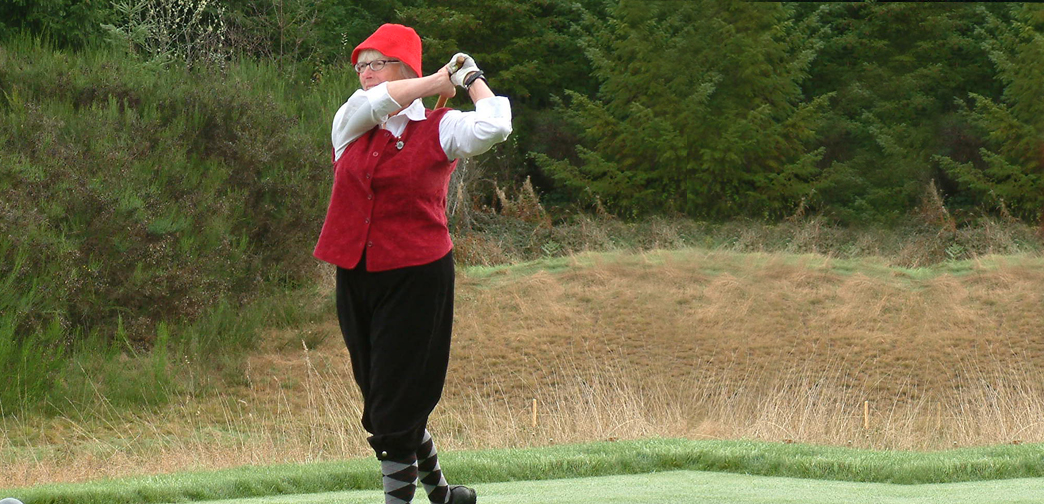Goose Cup Rules
NWHP Goose Cup Individual Match Play – 2021
Hosted by: Goose Guenette
Tournament Director: Goose Guenette
INTRODUCTION:
32 player individual match play tournament to be played over the 2021 NWHP season.
All rounds will be played at a course mutually chosen by the players involved.
The players will be arranged by handicap index and matches assigned to minimize strokes given.
The intention is to encourage NWHP play between scheduled events and around scheduled events.
USGA rules of golf in effect.
Observe local rules in effect for play on the day of your match.
Preferred lies are not allowed unless stipulated as a local rule on the day of play.
Embedded ball rule in effect.
The Stymie rule will be in effect as defined in section 2-7.
All clubs in use must adhere to the SOHG equipment guidelines for tournament play.
The use of electronic or optical distance measuring devices is not allowed.
Bracket entry fee – $20
1-1 FORMAT:
- Single elimination tournament of 18 hole Individual Match Play events. Players compete in match play, head-to-head with the winning player, earning the opportunity to advance to the next round. There will be a consolation match to determine 3rd and 4th place.
- Two (2) separate sixteen (16) player brackets will be arranged. The winner of each bracket will meet in the Championship final. The runner up from each bracket will meet the consultation match to determine 3rd and 4th place.
- The player with the lowest net score on a given hole wins that hole. The match is won by the player that is leading by a number of holes greater than the number of holes remaining to be played. (e.g., 4 up with 3 holes to play – known as winning 4 & 3).
- If the match is even after 18 holes, players must continue, starting at hole #1, and play until a winner is decided by sudden death. You must see the Golf Shop staff about getting back on the course to complete the match.
- Stymie rule in effect – see section 2-7. Balls must not be picked up until holed out or conceded, unless inside six-inches of one another on the green, per the Stymie Rule. If subjected to a Stymie, one may not concede the blocking ball until one’s stroke in regulation has been made.
- All matches will be played from the agreed upon tees prior to commencing. In the event that both players agree, the match may be played from matching more difficult tees or easier tees. It is preferred that players play from the same tees. It is foreseeable that match participants may play from different tees (open vs ladies or open vs super senior) and tee decisions are at the discretion of the players involved. In these cases, the handicap system slope is intended to correct the tee difference. Eg: Goose vs Chelsea. Goose plays from White, Chelsea plays from Red. Strokes are assigned according to section 1-2.
- All matches must be completed within the time window for each round as specified in section 1-4.
- Contact the tournament director once your match has been set with course details. The tournament director will assist in calculating the stroke differential and provide instruction on how to prepare your scorecard.
- In the event that a match can not agree on a date within the allotted time, the tournament director will select a course and set final time the last day the match can be played as close to 8:00 AM as possible. In the event that one of the players does not show for the round, the player prepared to play at that time will be declared the winner and advance to the next round. In the event that neither player shows up to play, both players will be disqualified and the player awaiting the winner will receive a bye to the next round.
- In the event that a match cannot be made in the allotted time due to personal schedules and both players are willing to play within 1 week of the end of a round, a petition may be made to the tournament director for an extension of up to 1 week to complete the match. The petition must be made 1 week prior to the end of the round scheduling period.
1-2 HANDICAPS:
- Each player receives 100% of his or her course handicap.
- SOHG handicaps will be used.
- Players without a SOHG will play as scratch.
- The handicap stroke allocations to be used for each match shall be net differential from the lower handicap player in the match.
- Example. Player A has a course index of 10, his opponent Player B has a course index of 20. Player A will play as a 0 handicap, Player B will play as a 10 course index. Dots are assigned to the card by hole handicap which means players will receive their stroke advantage on the 10 most difficult holes in this example.
1-3 SCORE CARDS:
- Fill in your score card completely! Record each player’s gross score on every hole. Circle the winning score for each hole. Add up everybody’s gross scores. Clearly mark on the front of the card the match play score (for example “Smith d. Fonda 2 & 1”). Sign, attest, and date your card and send a picture or return it to the tournament director.
1-4 SCHEDULE:
Round 1 – 1/28 thru 5/15
Bracket Quarterfinals – 5/15 thru 7/1
Bracket Semi-Finals – 7/1 thru 8/15
Bracket Finals – 8/15 thru 9/15
Final & Consultation – 9/15 thru 10/15
Additional Rules and Information
2-1 DESCRIPTION
A match consists of one side playing against another over a stipulated round, unless otherwise decreed by the committee. In match play, the game is played by holes. Except, as otherwise provided in the rules, each hole is won by the side holing out in the fewest number of strokes. In a handicap match, the lower net score wins the hole. The state of the match is expressed by the following terms: so many “holes up’’ or “all square,’’ and so many “to play.’’
A side is “dormie” when it is as many holes up as there are holes remaining to be played.
2-2 HALVED HOLE
A hole is halved if each side holes out in the same number of strokes. When a player has holed out and his opponent has been left with a stroke for the half, if the player subsequently incurs a penalty, the hole is halved.
2-3 WINNER OF MATCH
A match is won when one side leads by a number of holes greater than the number remaining to be played.
If there is a tie, the committee may extend the stipulated round by as many holes as are required for a match to be won.
2-4 CONCESSION OF MATCH, HOLE OR NEXT HOLE
- A player may concede a match at any time prior to the start or conclusion of that match.
- A player may concede a hole at any time prior to the start or conclusion of that hole.
- A player may concede his opponent’s next stroke at any time, provided the opponent’s ball is at rest. The opponent is considered to have holed out with his next stroke, and the ball may be removed by either side.
- A concession may not be declined or withdrawn.
- Ball overhanging hole—see Rule 16-2.
2-5 DOUBT AS TO PROCEDURE; CLAIMS, RESULT
In match play, if a doubt or dispute arises between the players, a player may make a claim. If no duly authorized representative of the committee is available within a reasonable time, the players must continue the match without delay. The committee may consider a claim only if the player making the claim notifies his opponent (i) that he is making a claim, (ii) of the facts of the situation and (iii) that he wants a ruling. The claim must be made before any player in the match plays from the next teeing ground or, in the case of the last hole of the match, before all players in the match leave the putting green.
A later claim may not be considered by the committee unless it is based on facts previously unknown to the player making the claim, and the player had been given wrong information (Rules 6-2a and 9) by an opponent.
Once the result of the match has been officially announced, a later claim may not be considered by the committee unless it is satisfied that the opponent knew they were giving wrong information.
The privilege of playing a second ball under Rule 3-3 does not exist in match play.
2-6 GENERAL PENALTY
The penalty for a breach of a rule in match play is loss of hole, except when otherwise provided.
Decision 2-5/1 Player’s Obligation Regarding Lodging Claim
In match play, a player may disregard a breach of the rules by their opponent, provided there is no agreement between the players. There is a difference between overlooking an opponent’s breach and an agreement with the opponent to waive a penalty. Rule 1-3 prohibits the latter.
Decision 2-5/2 Procedure for a Valid Claim
For a claim to be valid, the claimant must notify their opponent (i) that they are making a claim, (ii) of the facts of the situation and (iii) that they want a ruling. They must do so within the time required by Rule 2-5. For example, Rule 16-1e prohibits putting from a stance astride an extension of the line of putt behind the ball. In a match between A and B, if A putts from a stance astride an extension of the line and B states “that is not allowed, you are penalized,” or, “I’m making a claim because of that stroke,” the committee should consider the claim.
Statements by B such as “I’m not sure that’s allowed,” or, “I don’t think you can do that,” do not by themselves constitute a valid claim, because each statement does not contain the notice of a claim, the facts of the situation and an indication that they want a ruling.
2-7 STYMIE RULE
Balls must not be picked up until holed out or conceded, unless within 6 inches of one another on the green. In singles match play when one player’s ball has blocked the path of another player’s ball on the green, the obstructing player’s ball is not lifted. The only exception is if the opponents ball is within 6 inches of the player’s ball or 6 inches from the cup. In that situation, the blocking ball may be marked (but not cleaned) or holed. The 6 inches is measured from the nearest part of the ball to the nearest part of the second ball or the cup.
If subjected to a Stymie, one may not concede the blocking ball until one’s stroke in regulation has been made.
The player who is further away from the hole has to attempt to play the putt around–or above–the obstacle ball – including chipping. There is no penalty for striking the obstructing ball.
If a ball is lifted, per this Rule, it may not be cleaned. It may be placed away from the line of play and replaced on the player’s turn.
If contact happens, the player’s opponent when it is their turn to play, has the choice to take the putt from his ball’s original position or the new lie.
If the player’s ball knocks the obstructing ball into the cup, the opponent is considered to have holed out on the previous shot. For example, a ball lying 3 on the green is knocked into the hole by another ball—in this instance the score for the player whose ball was knocked into the hole would be 3.







